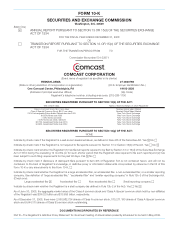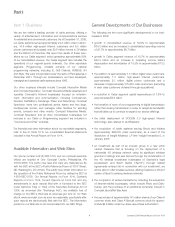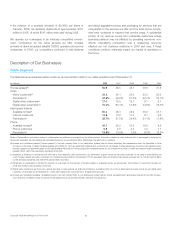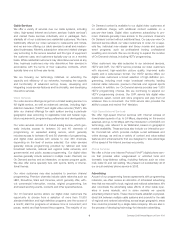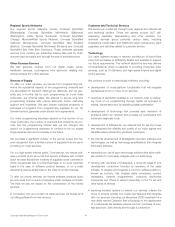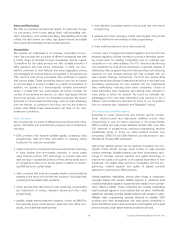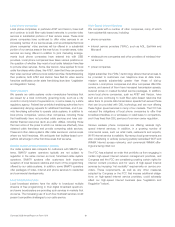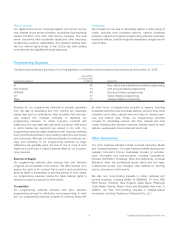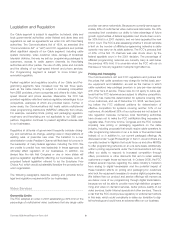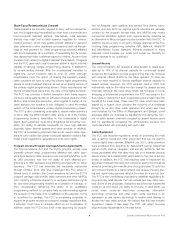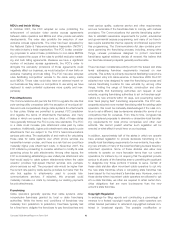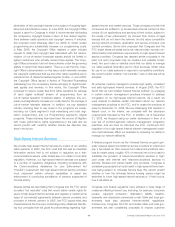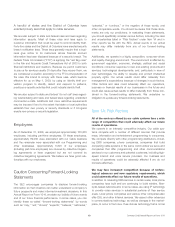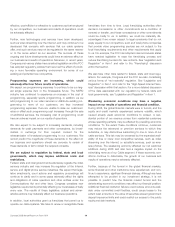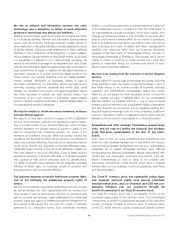Comcast 2008 Annual Report Download - page 7
Download and view the complete annual report
Please find page 7 of the 2008 Comcast annual report below. You can navigate through the pages in the report by either clicking on the pages listed below, or by using the keyword search tool below to find specific information within the annual report.Sales and Marketing
We offer our products and services directly to customers through
our call centers, door-to-door selling, direct mail advertising, tele-
vision advertising, local media advertising, telemarketing and retail
outlets. We also market our video, high-speed Internet and digital
phone services individually and as bundled services.
Competition
We operate our businesses in an intensely competitive environ-
ment. We compete with a number of different companies that offer
a broad range of services through increasingly diverse means.
Competition for the cable services we offer consists primarily of
DBS operators and local phone companies. In 2008, our com-
petitors continued to add features and adopt aggressive pricing
and packaging for services that are comparable to the services we
offer, and the local phone companies have continued to expand
their service areas. These competitive factors have had an impact
on and are likely to continue to affect our results of operations. In
addition, we operate in a technologically complex environment
where it is likely that new technologies will further increase the
number of competitors we face for our video, high-speed Internet
and phone services, and for our advertising business. We expect
advances in communications technology, such as video streaming
over the Internet, to continue in the future, and we are unable to
predict what effects these developments will have on our busi-
nesses and operations.
Video Services
We compete with a number of different sources that provide news,
sports, information and entertainment programming to consumers,
including:
• DBS providers that transmit satellite signals containing video
programming, data and other information to receiving dishes
located on the customer’s premises
• certain local phone companies that have built and are continuing
to build wireline fiber-optic-based networks, in some cases
using Internet protocol (“IP”) technology, to provide video and
data services in substantial portions of their service areas and in
an increasing number of our service areas, in addition to market-
ing DBS service in certain areas
• other providers that build and operate wireline communications
systems in the same communities that we serve, including those
operating as franchised cable operators
• online services that offer Internet video streaming, downloading
and distribution of movies, television shows and other video
programming
• satellite master antenna television systems, known as SMATVs,
that generally serve condominiums, apartment and office com-
plexes, and residential developments
• local television broadcast stations that provide free over-the-air
programming
• wireless and other emerging mobile technologies that provide
for the distribution and viewing of video programming
• video rental services and home video products
In recent years, Congress has enacted legislation and the FCC has
adopted regulatory policies intended to provide a favorable operat-
ing environment for existing competitors and for potential new
competitors to our cable systems. The FCC adopted rules favoring
new investment by local phone companies in networks capable of
distributing video programming and rules allocating and auctioning
spectrum for new wireless services that may compete with our
video service offerings. Furthermore, the FCC and various state
governments have adopted measures that reduce or eliminate local
franchising requirements for new entrants into the multichannel
video marketplace, including local phone companies. Certain of
these franchising entry measures have already been adopted in
many states in which we operate. We could be materially dis-
advantaged if FCC and state franchising rules continue to set a
different, less burdensome standard for some of our competitors
than for ourselves (see “Legislation and Regulation” below).
Direct broadcast satellite systems
According to recent government and industry reports, conven-
tional, medium-power and high-power satellites provide video
programming to over 35 million customers in the United States.
DBS providers with high-power satellites typically offer more than
250 channels of programming, including programming services
substantially similar to those our cable systems provide. Two
companies, DIRECTV and DISH Network, provide service to sub-
stantially all of these DBS customers.
High-power satellite service can be received throughout the con-
tinental United States through small rooftop or side-mounted
outdoor antennas. Satellite systems use video compression tech-
nology to increase channel capacity and digital technology to
improve the quality and quantity of the signals transmitted to their
customers. Our digital cable service is competitive with the pro-
gramming, channel capacity and quality of signals currently
delivered to customers by DBS providers.
Federal legislation establishes, among other things, a compulsory
copyright license that permits satellite systems to retransmit local
broadcast television signals to customers who reside in the local tele-
vision station’s market. These companies are currently transmitting
local broadcast signals in most markets that we serve. Additionally,
federal law generally provides satellite systems with access to cable-
affiliated video programming services delivered by satellite. DBS
providers also have arrangements with local phone companies in
which the DBS provider’s video services are sold together with a local
phone company’s high-speed Internet and phone services.
5Comcast 2008 Annual Report on Form 10-K

